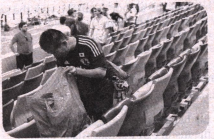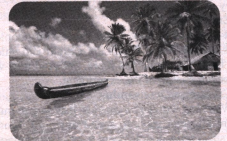
科目: 来源: 题型:
C

Japanese fans who watched their national team be defeated by the Ivory Coast on Saturday showed it is possible to lose graciously(优雅地), when they stayed behind after the match to help clean up.
Despite seeing Japan,s Blue Samurais lose 2-1 against the Ivory Coast's national team at the Arena Pernambuco in Recife,the Japanese audience armed with plastic bags searched their side of the stadium and gathered up dropped litter. While gathering waste after a sporting event is customary in Japan,the audience's actions came as a shock to football fans from other countries.
This isn't the first time the Japanese have taken trash outside the stadium. The 1998 FIFA World Cup held in France was the first ever World Cup that Japan had qualified for. After their first group game against Argentina,the Japanese fans gave the world a lesson in politeness and respect by actually cleaning the football stadium seats. They picked up all the trash around them whether it was theirs or not. They then walked out and threw the trash in the garbage cans before leaving.
The all-around cleanliness of Japanese large cities comes as a culture shock to people coming from other big cities in the world. This tidiness is not due to millions of dollars spent on street cleaners and “Let's clean-up our city” campaigns. It's not due to effective public works or community service. It's due to one simple thing: They don't throw their rubbish on the. floor. This unique and rare concept allows for both huge cities and the countryside to stay neat and tidy.
To reinforce (加强) this behavior,the common signs in Japan ask people to take their litter home with them. Then,to reinforce the sign,they usually have no garbage cans in the parks. So when faced with the choice-of throwing their garbage on the ground or keeping it with them,they keep it. They don't need a “Don’t Litter” or “Keep Japan Beautifur,sign. They have been doing it their whole lives and are used to taking their garbage with them.
28. The story in Paragraph 3 mainly shows that.A. Japanese people are used to carrying their own trash
B. Japanese fans have a habit of cleaning up the stadium
C. Japanese fans often clean stadium seats before the game
D. the Japanese are very interested in watching football games
29. What can we say about Japanese big cities’cleanliness?
A. It has become common practice.
B. It is the result of community service.
C. It costs millions of dollars every year.
D. It exists because of public campaigns.
30. Which of the following do the Japanese accept as normal?
A. Punishing the behavior of littering.
B. Many signs reading “Don’t Litter”.
C. Lots of garbage cans in the parks.
D. Taking litter away with them.
31. The author’s attitude to the Japanese audience might be that of .
A. criticism B. unconcern
C. respect D. doubt
查看答案和解析>>
科目: 来源: 题型:
B
One of the most significant parts of my high school career would be playing in the orchestra. I remember when I first started playing the viola(中提琴) in my school's program as an inexperi-enced iourth grader. As my interest in music grew,I decided to find a private instructor.
During my first lesson,I was surprised at what Dr. T was teaching — how to hold the viola and play open strings!To me,these were basic concepts I had long ago mastered. However,the following week,what I thought I had learned was completely disproven. With such high expectations,Dr.T criticized many aspects of my posture, intonation and bowing(音准和弓法).But as I became more familiar with my viola,Dr. T started assigning me actual compositions. Meanwhile,I became more and more interested in our school's ensemble(合奏组).
I first decided to become a section leader in middle school,when we were given the opportunity to try out for our ensemble's first and second chairs.During the first class,our conductor,Mrs.V,introduced us to a section leader's responsibilities .These duties included helping others with the concert music and setting a good example. After discussion,I decided to try out and started preparing the assigned piece. Every day,I would;practice for at least 45 minutes. Needless to say,this was easier said than done. It required a lot of concentration and will power. Regardless,by the end of the week,I had become more familiar with the music.
To my suiprise,the audition (试听) process was more pleasant than I had imagined. As I unpacked my viola,I started to doubt my decision. However,when I entered Mrs. V's homely office,I felt more relaxed. By the end of my audition,Mrs. V said that I had a good chance of becoming the principal violist!The next day,during orchestra,I learned that indeed,I had become our section's first chair.
24. Before the author studied under Dr. T,she.
A. had never played the viola
B. had expressed interest in music
C. had written some compositions
D. had been a promising young artist
25. The underlined word “disproven” in Paragraph 2 can be replaced by “”.
A. lazy B. wrong
C. foolish D. surprised
26. Which of the following can best describe the author?
A. Unusual and scholarly.
B. Self-centered and proud.
C. Independent and optimistic.
D. Hard-working and determined.
27. When attending the audition,the author.
A. felt confident of succeeding
B. received some careers guidance
C. left a good impression on Mrs. V
D. remembered her first viola instructor
查看答案和解析>>
科目: 来源: 题型:
第一节(共H小题;每小题2分,满分30分)
阅读下列短文,从每题所给的四个选项(A、B、C和D) 中,选出最佳选项。
A

We are sailing toward the San Bias Archipelago,a chain of more than 360 islands in the Caribbean Sea.
“There's a boat!” Our daughter Hayley shouts suddenly.
Three men,far out at sea,are in a canoe called a cayuco. We pull up near them and they offer to sell us a spiny lobster(龙虾) ,but they have not caught enough for each of us.
“Un momento,por favor [One moment,please],” the man says.
He dives overboard,holding his breath,goes down 40 feet, and comes back up with another lobster in his bare hands!We buy the lobsters and visit with the men.
These fishermen are the Kuna Indians from the San Bias Islands. The Kuna Indians have made their homes famous because of their efforts to protect their rain forests,their independence,and their culture.
For more than 400 years,the Kuna Indians have fought to keep their traditional way of life. They,ve formed their own system of government and laws. They,ye kept the Kuna language,though many speak Spanish,too. And while visitors are welcome,non-Kuna people are not allowed to own land.
Once we are on the island,we visit the sahila,or chief. It is an important part of Kuna culture for a visitor to receive an invitation and pay a fee to the sahila before entering,his village. We walk around the village and look at the way the Kuna people live. Kuna villages vary in size. They can range from a few dwellings(住所) to large villages with.some modem conveniences.
Hayley and her brother Jackson are being homeschooled while we are traveling on our boat. Part of our homeschool day is spent learning about the countries and people we visit. Earlier today we read about Kuna foods and money. The Kuna eat a lot of fish,lobsters and coconuts (椰子) .The coconut is also used for money. Each coconut tree has a Kuna owner,so the coconuts cannot be taken or touched.
21. According to the text,the Kuna Indians have been trying their best to.
A. expand their land
B. prevent strangers visiting
C. keep their traditions alive
D. learn more about the outside world
22. Why does the author's family visit the sahila?
A. To ask for his help.
B. To show respect for him.
C. To invite him to travel with them.
D. To get permission to enter his village.
23. The main purpose of this text is to introduce.
A. the meaning of traveling
B. the benefits of homeschooling
C. the history of the San Bias Islands
D. the native people living on the San Bias Islands
查看答案和解析>>
科目: 来源: 题型:
选用方框内合适的短语并用其正确形式填空(每个短语限用一次) 。
take in,team up with,mark out,back to back,狂 great many,apply for
1. Stand and let's see who is taller.
查看答案和解析>>
湖北省互联网违法和不良信息举报平台 | 网上有害信息举报专区 | 电信诈骗举报专区 | 涉历史虚无主义有害信息举报专区 | 涉企侵权举报专区
违法和不良信息举报电话:027-86699610 举报邮箱:58377363@163.com